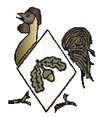
The 11th (Northern) Division, was an infantry division of the British Army during the First World War, raised from men who had volunteered for Lord Kitchener's New Armies. The division fought in the Gallipoli Campaign and on the Western Front. The division's insignia was an ankh or ankhus.

The 24th Division was an infantry division of the British Army, raised in September 1914 from men volunteering for Lord Kitchener's New Armies during the First World War. After almost a year spent training in England the division was sent to the Western Front between August and September 1915. It served in Belgium and France in the trenches of the Western Front for the duration of the war.

The 41st Division was an infantry division of the British Army, raised during the First World War as part of Lord Kitchener's New Armies. The division saw service on the Western Front and later on the Italian Front.

The 23rd Division was an infantry division of the British Army raised in 1914 in the Great War as part of Kitchener's Army. The division was sent to France in August 1915 under the command of Major-General Sir James Melville Babington C.B. C.M.G. During the war the division fought on the Western Front until October 1917 when it moved to the Italian Front. It remained in Italy and was disbanded by March 1919.
The 22nd Division was an infantry division of the British Army during World War I, raised in September 1914, from men volunteering for Lord Kitchener's New Armies. The division moved to France in September 1915, but it was transferred to Greece only one month later. It served in the Balkans Campaign for the duration of the First World War.

The 40th Division was an infantry division of the British Army active during the First World War, where it served on the Western Front. It was a division of Lord Kitchener's New Army volunteers, mostly "bantam" recruits of below regulation height. It was later briefly reformed as a deception formation in the Second World War, and during the early years of the Cold War was recreated a third time to garrison Hong Kong.
The 28th Division was an infantry division of the British Army raised for service in World War I.
The 25th Division was an infantry division of the British Army, raised as part of Lord Kitchener's Third New Army (K3) in September 1914, shortly after the outbreak of the Great War. It served on the Western Front for most of the war.

The 37th Division was an infantry division of the British Army, raised during the First World War. The divisional symbol was a gold horseshoe, open end up.

The 39th Division was an infantry division of the British Army, raised during the First World War. The division was part of Kitchener's New Armies and saw service on the Western Front and in Italy from 1916 onwards.

The 59th Division was an infantry division of the British Army during World War I. It was formed in late 1914/early 1915 as a 2nd Line Territorial Force formation raised as a duplicate of the 46th Division. After training in the United Kingdom and saw service in the Easter Rising in April 1916, the division joined the British Expeditionary Force (BEF) on the Western Front in early 1917. It saw action at Ypres and Cambrai, and was almost destroyed during the German Army's Spring Offensive in March 1918. The reconstituted division took part in the final advances of the war.
The 121st Brigade was an infantry brigade formation of the British Army during World War I. Part of Lord Kitchener's 'New Armies', it served in the 40th Division on the Western Front. The brigade number was reactivated for deception purposes during World War II.
The Staffordshire Brigade was a volunteer infantry brigade formation of the British Army from 1888 to 1936. It saw active service on the Western Front in World War I, including the attacks on the Hohenzollern Redoubt and the Gommecourt Salient, and the assault crossing of the St Quentin Canal, 'a most remarkable feat of arms'.
The 178th Brigade was an infantry brigade of the British Army. The brigade saw active service during the First and the Second World Wars.

The Attack on the Gommecourt Salient was a British operation against the northern flank of the German 2nd Army. The attack took place on 1 July 1916, on the Western Front in France, during the First World War. The attack was conducted by the British Third Army as a diversion, to protect the northern flank of the main attack. The British Fourth Army on the First day on the Somme, attacked from Serre southwards to the boundary with the French Sixth Army at Maricourt. To extend the attack front of the Fourth Army, the VII Corps of the Third Army was to capture the Gommecourt Salient, the most westerly point of the Western Front. In the first week of May, the 56th Division and the 46th Division moved into the area for the attack. By 10 May, both divisions had taken over the front on the right flank of the 37th Division and begun training for the operation, making no attempt to conceal the preparations.

The 1st Staffordshire Artillery Volunteers, later 2nd North Midland Brigade, was a Volunteer unit of the Royal Artillery of the British Army recruiting primarily from Staffordshire. It fought on the Western Front during World War I and in the Normandy Campaign and Belgium, Holland, and Germany during World War II. Postwar, it was reformed as a specialist locating unit.
The North Midland Divisional Engineers was a Territorial Force unit of the British Royal Engineers created in 1908 by conversion of a volunteer infantry battalion from Staffordshire. It saw action in World War I at the Hohenzollern Redoubt, Gommecourt, Ypres, Cambrai, the German spring offensive and the Hundred Days Offensive, culminating in the assault crossings of the St Quentin Canal, the Selle and the Sambre. During World War II its component units saw action in the Battle of France, in Greece, Tunisia, Italy, Normandy and the Rhine crossing.
The 139th Brigade was an infantry brigade of the British Army that saw active service in the First World War with the 46th Division. Later designated the 139th Infantry Brigade, the brigade also saw service with the 46th Infantry Division in the Second World War.
The High Peak Rifles, later 6th Battalion, Sherwood Foresters, was a volunteer unit of Britain's Territorial Army. First raised in the High Peak area of Derbyshire in 1860, it fought as infantry on the Western Front during the First World War and as an air defence unit during the Second World War. Its descendants remained in the Army Reserve until 2014.

The 5th Battalion, Lincolnshire Regiment, was a volunteer unit of Britain's Territorial Army from 1900 until 1967, serving as infantry on the Western Front during the First World War and as an air defence unit during and after the Second World War.
















